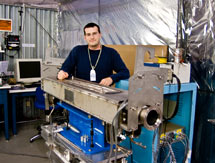
Handy Links
SLAC News Center
SLAC Today
- Subscribe
- Archives: Feb 2006-May 20, 2011
- Archives: May 23, 2011 and later
- Submit Feedback or Story Ideas
- About SLAC Today
SLAC News
Lab News
- Interactions
- Lightsources.org
- ILC NewsLine
- Int'l Science Grid This Week
- Fermilab Today
- Berkeley Lab News
- @brookhaven TODAY
- DOE Pulse
- CERN Courier
- DESY inForm
- US / LHC
SLAC Links
- Emergency
- Safety
- Policy Repository
- Site Entry Form

- Site Maps
- M & O Review
- Computing Status & Calendar
- SLAC Colloquium
- SLACspeak
- SLACspace
- SLAC Logo
- Café Menu
- Flea Market
- Web E-mail
- Marguerite Shuttle
- Discount Commuter Passes
-
Award Reporting Form
- SPIRES
- SciDoc
- Activity Groups
- Library
Stanford
Around the Bay
People: Jeff Smith Helps Keep the LHC Beam in Check
Here at SLAC, Jeff Smith studies collimation systems, which he describes as machine protection structures for the Large Hadron Collider. While designing a collimator may not sound as flashy as colliding proton beams, it is a necessary precaution to protect nearby equipment from the collider's high-energy beams.
"Collimators take the brunt of the beam energy," Smith added. "The LHC would not operate without this system."
Smith's research won him the the American Physical Society California Section Luis Alvarez Award for Best Experimental Research, an annual award handed out to scientists from California and Nevada. "The most challenging aspect is creating a rotating device that is straight to within 25 microns," Smith said, explaining that there is little room for error when firing a particle beam through a narrow beam pipe.
Coming to SLAC for his postdoc was an easy decision for Smith, as he spent about seven months here during his graduate work in physics at Cornell. He's currently trying to find a way to improve the collimators for the LHC and frequently travels to Geneva, Switzerland to work with the LHC team on site. "The most fun part of it is I feel like I'm a member of two different labs," he said.
The existing collimators are not built for maximum beam intensity, putting a bit of a "speed limit" on current accelerator experiments. Researchers hope that improving the equipment will support higher luminosity—beams with more particles packed into a tightly focused area, for higher-energy collisions.
Though collaborating with a much larger group at CERN, Smith works in a team of six here at SLAC. "It's fun," he said, "but people have to take on many different roles." Fortunately, he prefers being involved in various stages of the work and seeing how the pieces fit into collimator development.
A beam of particles traveling through an accelerator sheds particles in transit, much as water from a hose nozzle sprays mist. These particles land on the collimators in the LHC, which are currently lined in graphite, and are absorbed instead of scattering onto delicate equipment.
Smith and his colleagues aim to improve the LHC collimation system by finding a better lining material than graphite, because particles can easily pass through this light material. The trick is finding a metal that is solid enough to absorb particles but will not be damaged or destroyed in the heat caused by the impacts.
But it's not just loose protons that Smith and his colleagues need to worry about: a collimator must also guard against accidents from a mis-steered beam. The LHC beams contain about 360 megajoules of stored energy, equivalent to 80 kilograms of TNT. Most materials cannot withstand a direct beam hit and a mis-steered beam would seriously damage the collimator. So Smith and his colleagues are building a rotatable collimator. If a beam strikes a rotatable collimator, then physicists could simply rotate the collimator to continue working with an undamaged surface.
Smith and his colleagues plan to begin testing the new rotatable collimator at CERN next August, and are constructing the prototype in the meanwhile. "The big challenge is having a mechanically rotating device in an accelerator environment."
—Julie Karceski
SLAC Today, January 13, 2010
